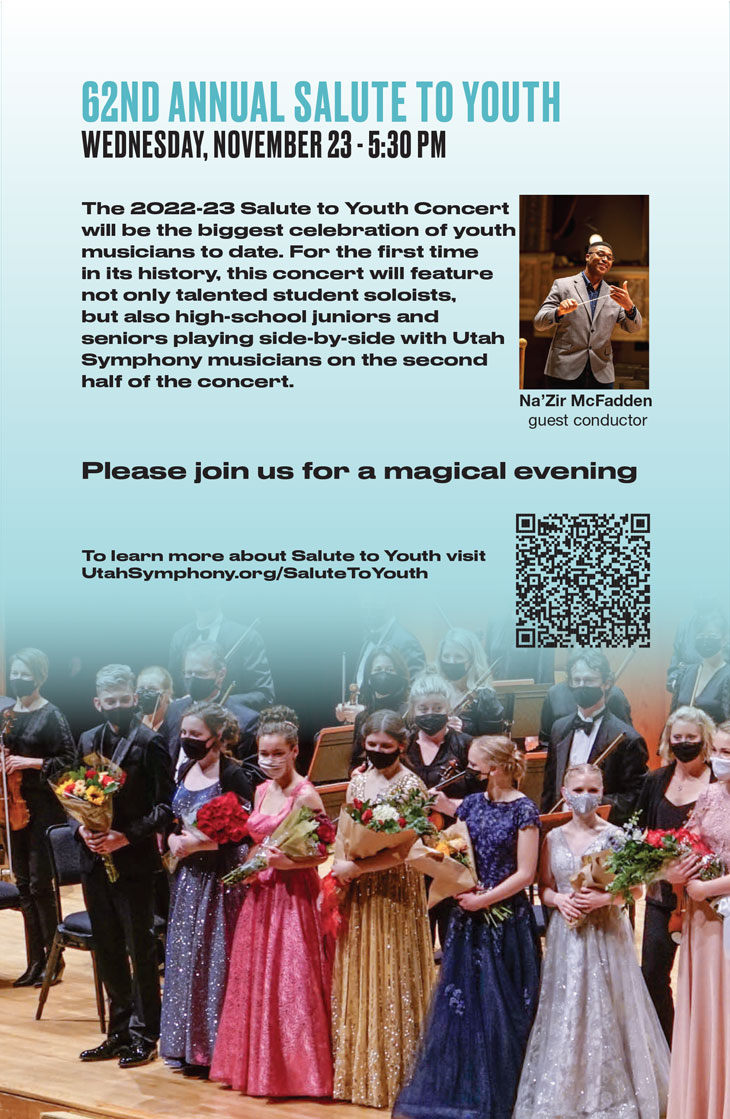Utah Symphony
History of the Music
History of the Music

By Jeff Counts
Violin Concerto
Duration: 34 minutes in three movements.
THE COMPOSER – PIOTR ILYICH TCHAIKOVSKY (1840-1893) – Tchaikovsky was a man quite accustomed to emotional dissonance and discomfort, and likely expected life to challenge him at every turn. And why not? It had so often obliged. But even an experienced pessimist like Tchaikovsky must have been unprepared for one of his most painful professional experiences to repeat itself so literally in 1878. His Piano Concerto No. 1 had been written in 1875 and after Nicolai Rubenstein refused to play it (and crushing the composer with one of the least graceful critiques in the history of music), the premiere had to be moved to Boston. The stage was set for an encore performance of this embarrassing drama only three short years later.
THE HISTORY – Obviously, Mr. Rubenstein was wrong about Piano Concerto No. 1. It has become an anchor work in the repertoire, a status it deserves, and its popularity among high profile pianists has never waned. Even Rubenstein himself abandoned his minority opinion eventually and added it to his repertoire. Tchaikovsky began work on the Violin Concerto in the spring of 1878 and completed it in about a month. Its dedicatee was Leopold Auer, a Hungarian virtuoso who taught at the St. Petersburg Conservatory. Years later, Auer recalled the moment when Tchaikovsky presented him with the score, already in print and already dedicated to him. “I regretted that the great composer had not shown it to me before…,” he recounted, “Much unpleasantness might then have been spared us both.” The rest of Auer’s interview is a confession of sorts, in which the violinist lists his objections to the music, but also admits he was wrong to reject the premiere. His closing comment about how it is “impossible to please everybody” intimated that he might never fully endorse a work that persisted without his unsolicited amendments. But he did, and became a real champion of the piece later in his life. For his part, Tchaikovsky spurred his wounded pride into action by publishing a second edition right away, complete with a new dedication. Adolf Brodsky knew the opportunity before him and seized it by premiering the concerto in Vienna in 1881. Brodsky apparently played beautifully, but the performance did not go over. Critical commentary from that night is as brutal as anything Rubenstein ever said and so much crueler than the merely disappointed Auer’s reaction. Tchaikovsky reportedly carried around Eduard Hanslick’s scathing indictment (complete with a comment about how it is possible to “hear” the stink of something) for months. Just like in 1875, though, everyone would be proven wrong. The Violin Concerto stands so easily now next to Mendelssohn, Beethoven and Brahms; it is difficult to imagine it was ever otherwise.
THE WORLD – Elsewhere in 1881, the First Boer War came to an end, the Gunfight at the O.K. Corral occurred, and Scottish footballer Andrew Watson became the first black man to play international soccer.
THE CONNECTION – Tchaikovsky’s Violin Concerto was last performed by the Utah Symphony on the Masterworks Series in 2020. Thierry Fischer conducted and Karen Gomyo was soloist.
By Michael Clive
Symphony No. 4 “Italian”
Mendelssohn’s musical ideas were inspired by the grand tour of Europe that occupied the composer from 1829 to 1831. By then, Mendelssohn, around the age of today’s college sophomore, was broadly educated and a mature composer. The idea of young composers from elsewhere in Europe honing their styles in Italy was more than a century old; even the culturally chauvinistic French sent their best and brightest to Italy for two years with the Prix de Rome.
Extensive travels in Italy and brilliant letters sent home to a musically gifted sister were among the many strange coincidences linking Mendelssohn and Mozart. Felix’s letters reveal his euphoric embrace of Italian culture and landscape. In a February 1830 letter to his sister, Fanny, he references the Italian symphony: “It will be the jolliest piece I have ever done, especially the last movement. I have not found anything for the slow movement yet, and I think that I will save that for Naples.”
The Italian Symphony seems to achieve the impossible, musically capturing the brilliance of sunshine and the vibrancy of wine. Suffused with a sense of travel and of the golden Italian landscape (though not, arguably, with the flavor and dynamism of the Italians themselves), the symphony’s scenic melodies sweep us along. It’s worth noting the sense of drama that opens the symphony, conveying the excitement of both departure and arrival. The effect requires virtuosic precision of attack in the brasses from the very first moment, a challenge that at least one wag has described to your intrepid annotator as “the dilemma of the horns.”
